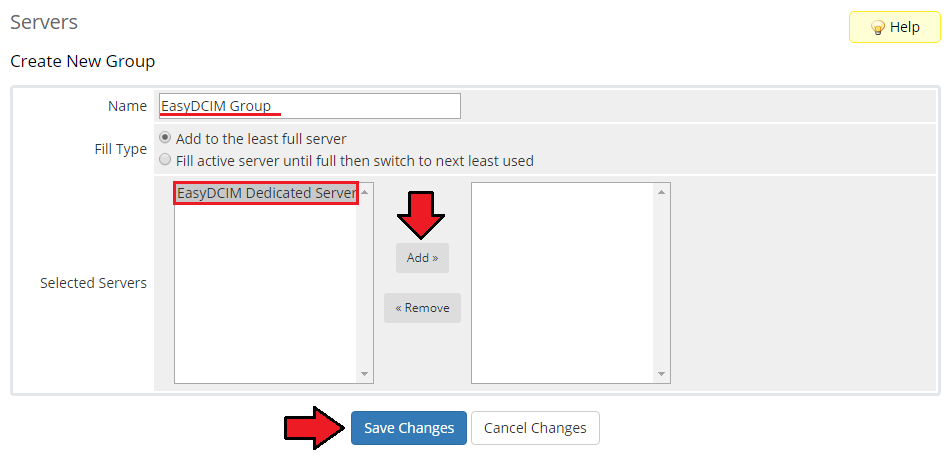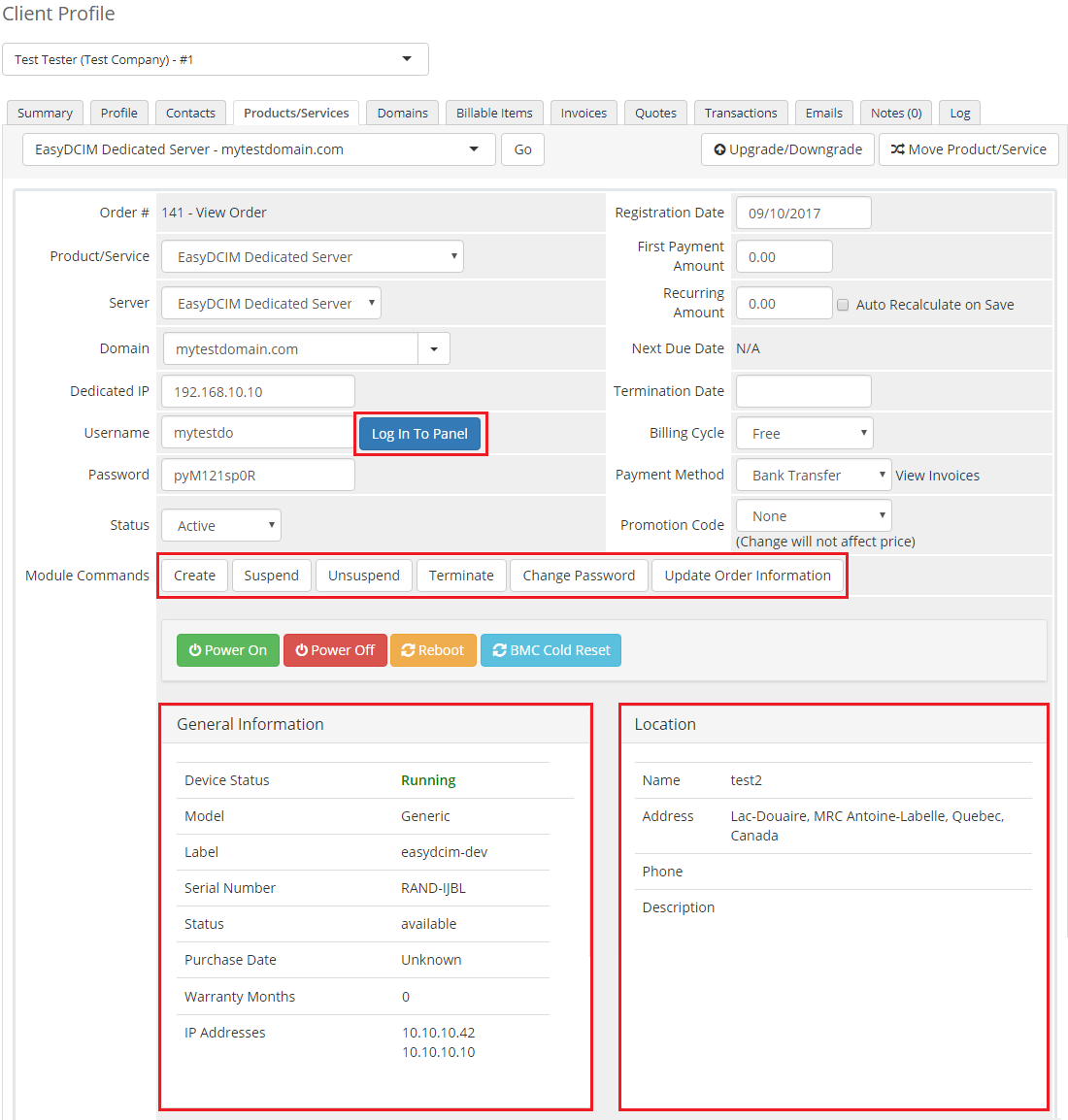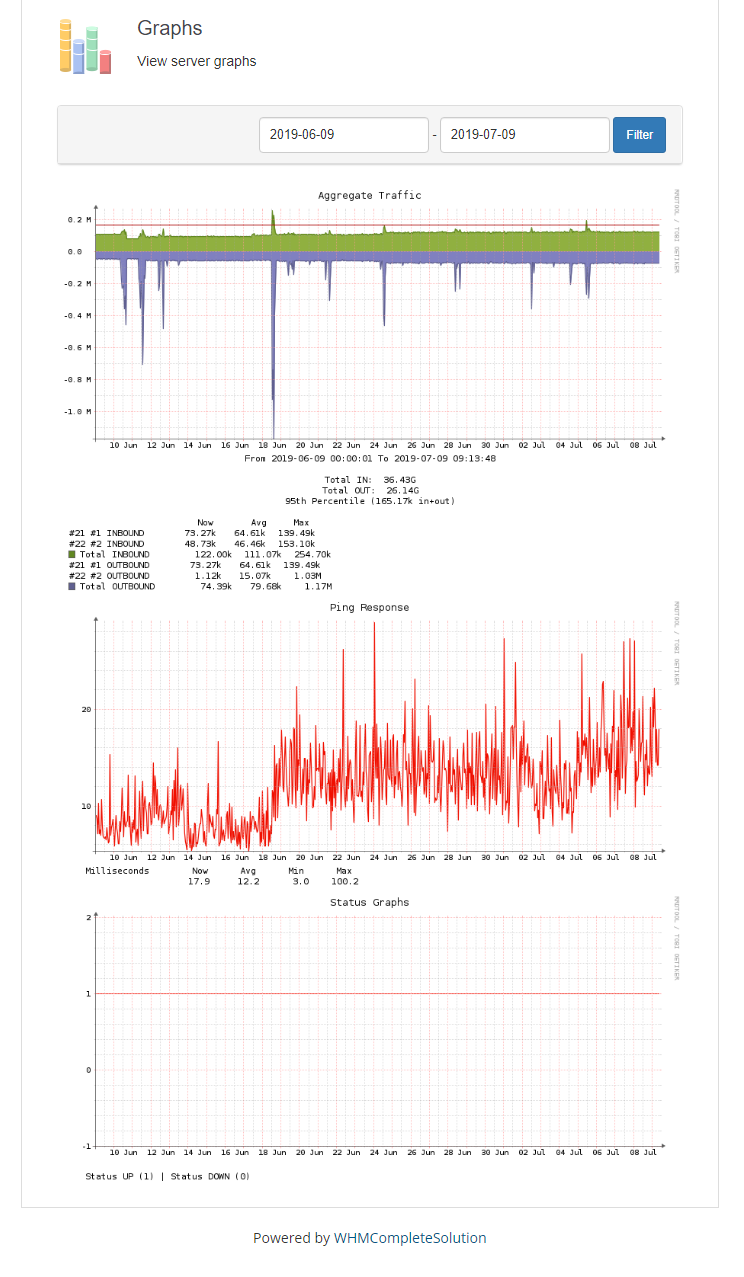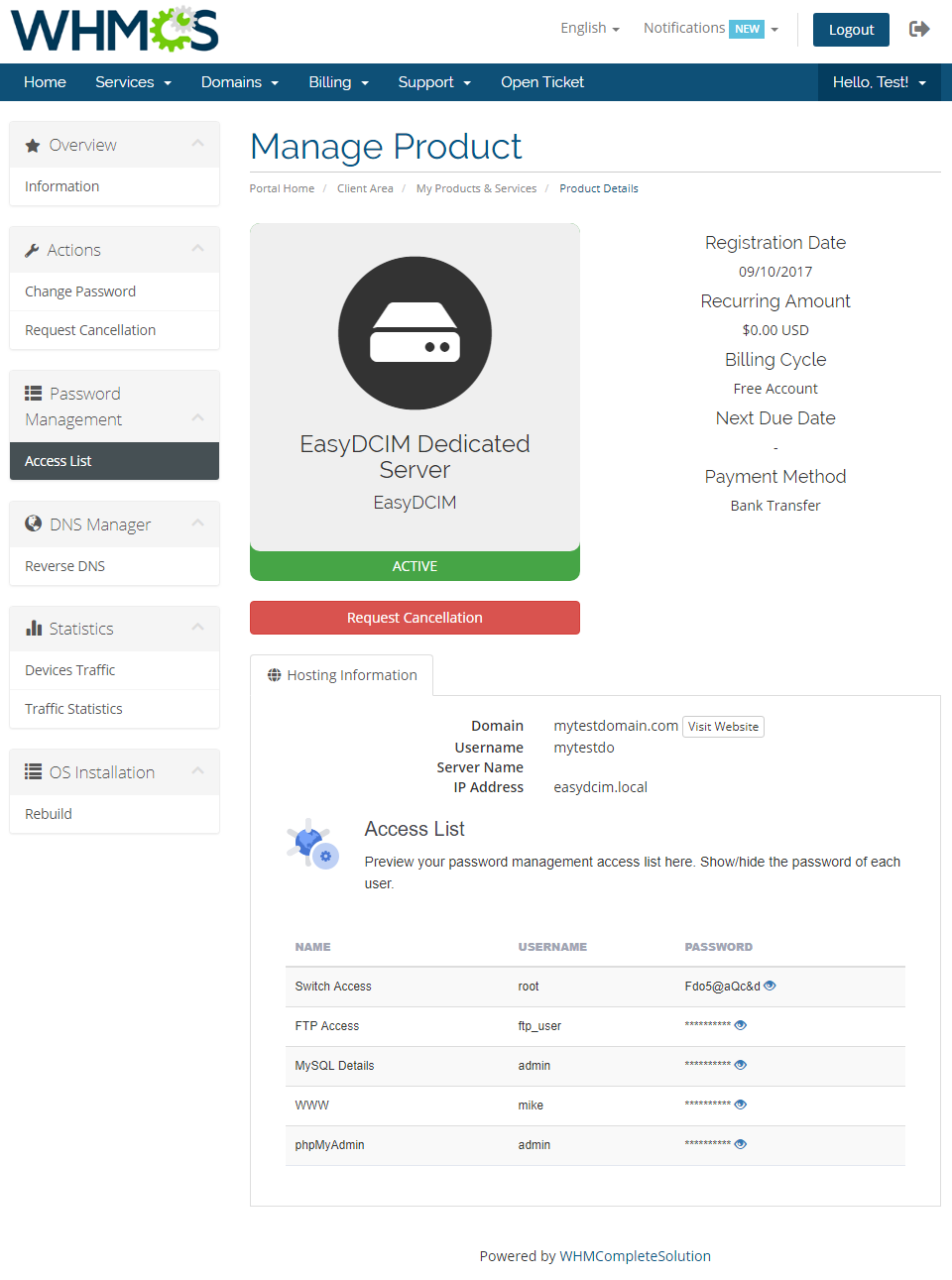EasyDCIM Dedicated Servers V1.X For WHMCS
Contents |
About EasyDCIM Dedicated Servers For WHMCS
| EasyDCIM Dedicated Servers For WHMCS will allow you to move the provisioning and management of EasyDCIM servers directly to your WHMCS. The module will let you handle all crucial aspects of created servers, including their status and the SSH password. |
- Admin Area Features:
| ✔ Create/Terminate/Suspend/Unsuspend Server |
| ✔ Boot/Reboot/Shut Down/BMC Cold Reset Server |
| ✔ Change Server SSH Password Field |
| ✔ View Server Details |
| ✔ View Server Resource Usage Graphs |
| ✔ Generate Default And Additional Parts Configurable Options |
| ✔ Configure Server: |
| ✔ Server Model |
| ✔ Server Location |
| ✔ OS Template |
| ✔ Server Resources |
| ✔ Toggle Automatic Order Acceptance And Server Matching |
| ✔ Define Required Devices |
| ✔ Define Additional Parts And Their Sizes: |
| ✔ HDD Models |
| ✔ SSD Models |
| ✔ RAM Models |
| ✔ CPU Models |
| ✔ Define Client Area Features |
| ✔ Choose OS Templates Available For Rebuilding |
| ✔ Control Service Access Level |
| ✔ Control Service Actions And Email Notifications |
| ✔ Determine Monthly Interval Of Bandwidth Usage |
| ✔ Define Percentile Billing Of Bandwidth Overages |
| ✔ One Click Login To EasyDCIM: |
| ✔ User Control Panel |
| ✔ Admin Panel |
| ✔ Use EasyDCIM Merge Fields In Email Templates |
| ✔ Toggle Debug Mode |
- Client Area Features:
| ✔ Boot/Reboot/Shut Down/BMC Cold Reset Server |
| ✔ Receive Email Notification On Complete Server Creation |
| ✔ Change Server Hostname |
| ✔ Change Server SSH Password Field |
| ✔ View Server Details |
| ✔ View SSH Access Details |
| ✔ Toggle Rescue Mode |
| ✔ Access KVM Java Console (Dell And SuperMicro Servers) |
| ✔ Access noVNC KVM Console (American Megatrends, Dell, HP And Supermicro) |
| ✔ View Access List With Stored Passwords |
| ✔ Manage Reverse DNS Records |
| ✔ Rebuild Server Using OS Templates And Your Own Credentials |
| ✔ View Server Resource Usage Graphs |
| ✔ View Traffic Statistics On: |
| ✔ Single Device |
| ✔ All User Devices |
| ✔ One Click Login To User Control Panel |
- Configurable Options:
| ✔ Server Model |
| ✔ Server Location |
| ✔ OS Template |
| ✔ Service Access (Hidden By Default |
| ✔ Bandwidth |
| ✔ Additional IP Addresses |
| ✔ HDD Size (Of Any Additional Parts) |
| ✔ SSD Size (Of Any Additional Parts) |
| ✔ RAM Size (Of Any Additional Parts) |
| ✔ CPU Cores (Of Any Additional Parts) |
| ✔ Custom - To Be Displayed In EasyDCIM Service Configuration |
- Advanced Billing Integration:
| ✔ Bill For Current Bandwidth Usage |
| ✔ Apply 95th Percentile Billing Of Bandwidth Overages |
- Supported Server Manufacturers:
| ✔ AMI |
| ✔ Dell |
| ✔ HP |
| ✔ Supermicro |
- General Info:
| ✔ Integrated With Advanced Billing For WHMCS - Actual Server Resource Usage Billing (read more) |
| ✔ Integrated With Products Reseller For WHMCS - End-To-End Solution For Products And Servers Reselling (read more) |
| ✔ Integrated With Server Allocator For WHMCS - Automatic Assignment Of Most Suitable Servers To Products (read more) |
| ✔ Multi-Language Support |
| ✔ Supports EasyDCIM v1.7.4 and Later |
| ✔ Supports PHP 7.2 Up To PHP 7.4 |
| ✔ Supports WHMCS Themes "Six" And "Twenty-One" |
| ✔ Supports WHMCS V8.0 And Later |
- Exclusive Promo Code From ModulesGarden:
| ✔ Save 25% For 3 Months On The EasyDCIM Control Panel With Coupon: WHMCS25%_ED |
Installation and Configuration
| This tutorial will show you how to successfully install and configure EasyDCIM For WHMCS. We will guide you step by step through the whole installation and configuration process. |
Installation
| 1. Log in to our client area and download the module. |

|
| 2. Upload and extract the files into the main WHMCS directory. Files in your WHMCS directory should look like on the following screen. |
Configuration of Server
| 3. Now, we will show you how to configure a new product. Go to 'Setup' → 'Products/Services' → 'Servers' and press the 'Add New Server' button. |

|
| 4. Next, choose 'EasyDCIM' from the 'Type' dropdown menu. Fill in your server name, IP address and password, then press 'Save Changes'. |

|
| 5. After configuring your server, you can check the connection. In order to check the connection with an EasyDCIM server, edit the server configuration and press 'Test Connection' as shown on the screen below. |

|
| 6. The next step is creating a server group. To do so, click on 'Create Server Group'. |

|
| 7. Enter the name, click on your previously created server, press 'Add' and 'Save Changes' afterwards. |

|
Configuration of Product
| 9. In order to create and configure a product, go to 'Setup' → 'Products/Services' → 'Products/Services'. Click on 'Create a New Group'. |

|
| 10. Enter the product group name and press 'Save Changes'. |

|
| 11. Once you have a product group, you can assign your product to it. To create a product, click on 'Create a New Product'. |

|
| 12. Next, choose your product group, enter your product name and then press 'Continue'. |

|
| 13. Now, go to the 'Module Settings' section, choose both 'EasyDCIM' and your previously created server group from dropdown menus. Do not forget to click 'Save Changes'. |

|
| 14. Before configuring the product, set up the EasyDCIM cron job, once per 5 minutes interval is suggested. |

|
| 15. The module configuration is only partly obligatory. The server will be assigned based on the provided configuration, and will therefore match only those options that have been specified.
Default Options:
Product Configuration
Additional Parts
Client Area Features
Service Actions
Service Notification
|

|
| 15. Now, you can optionally generate the default configurable options to allow placing orders tailored to your customers' needs. We recommend viewing and modifying them to fit your provisioning capabilities. You can find them under 'Setup' → 'Products/Services' → 'Configurable Options'. |

|
| 16. Additionally, you can set up a percentile billing for additional traffic. Note: This option is possible only if you do not have Advanced Billing Form WHMCS module installed. If you need a bit more advanced billing integration, please go here for more information.
E.g. If 'Soft Limit = 100' and 'Cost = 0.500' and the client exceeds the bandwidth by 10 Mbps, reaching to '110 Mbps' , they will be additionally charged with $5 USD (10 x 0.500). |

|
Custom Fields
| Once the configuration of the module settings has been completed, the following custom fields will be created automatically. Note: These fields will not be visible to clients by default.
|

|
Management
| In this section we will show you all possibilities of EasyDCIM Dedicated Servers For WHMCS. Our module allows you to offer and manage EasyDCIM servers right in your WHMCS system. |
Admin Area
|
As soon as you set up a server for a client, you can request various actions and view server details from the WHMCS admin area. |

|
| Our module allows you to boot/reboot/shutdown server, force BMC cold reset of the server as well as view its details. |

|
| Below the mentioned functions, there are various usage graphs and statistics available at your disposal. Note: By default, there are 4 types of statistics displayed. If you need more, you can add them though the configuration.json file located in /yourWHMCS/modules/servers/EasyDCIM/Config. |

|
Client Area
| In the client area your customers can view all details concerning their servers, manage their status remotely as well as log in to their EasyDCIM control panel with a single click. Other available actions on the server: Boot, Reboot, Shutdown, BMC Cold reset, Enable Rescue Mode. |

|
| Additionally, they can explore several usage graphs. |

|
Password Management
| Move to Password Management section to see a full list of all stored passwords. Press the icon next to the password to show/hide it. |

|
DNS Manager
| It is possible for your clients to control their reverse DNS. They can either edit the already existing records or create new ones. |

|
| To create a record, all your clients need to do is fill in the necessary information. The newly created record will immediately appear on the list. |

|
Statistics
Traffic Statistics
| Traffic Statistics section allows to view information about the traffic billing. Note: Available time intervals depend on the date of the product registration. |

|
Devices Traffic
| This section allows to view information on the total traffic on all of your devices in a form of a clear graph. Note: Available time intervals depend on the date of the product registration. |

|
OS Installation
| Finally, OS Installation sections gives the possibility to reinstall OS on the client's server. |

|
KVM Java Console
| If your clients are using Dell or SuperMicro servers, they can access the KVM Java console. |

|
| It will launch a Java applet that will automatically connect to your client's server. Note: The browser needs to have Java enabled with the correct permissions to make the console functioning. |

|
noVNC KVM Console
| For clients using the 'American Megatrends', 'Dell', HP' and 'Supermicro' servers there is available access to the noVNC KVM console. |

|
| noVNC KVM Console in contrast to KVM Console is not downloaded directly on the client's device, EasyDCIM connects with proxy server via VNC to allow the remote session. |
Email Templates Merge Fields
| Whmcs Email Templates are compatible with EasyDCIM and you may easily include EasyDCIM data in their content. In this section you will earn how to create merge fields that then can be used in email templates that you send to your clients. |
| The pattern of creating acceptable by WHMCS merge fields is very easy:
Let's take IP address as an exemplary EasyDCIM metadata. The WHMCS variable will be {$easydcim_ip_address}. As you have surely noticed:
|
| Here you can find a list of exemplary ready made variables: |
| EasyDCIM Metadata | WHMCS Merge Fields |
|---|---|
| Hostname | {$easydcim_hostname} |
| IP Address | {$easydcim_ip_address} |
| IPMI Enabled | {$easydcim_ipmi_enabled} |
| IPMI IP Address | {$easydcim_ipmi_ip_address} |
| IPMI Username | {$easydcim_ipmi_username} |
| IPMI Password | {$easydcim_ipmi_password} |
| IPMI Board Type | {$easydcim_ipmi_board_type} |
| IPMI Protocol Version | {$easydcim_ipmi_protocol_version} |
| IPMI Driver | {$easydcim_ipmi_driver} |
| IPMI Proxy Server | {$easydcim_ipmi_proxy_server} |
| IPMI Console Port | {$easydcim_ipmi_console_port} |
| IPMI Console Login URL | {$easydcim_ipmi_console_login_url} |
| IPMI Port | {$easydcim_ipmi_port} => string |
| IPMI Privilege Level | {$easydcim_ipmi_privilege_level} |
| IPMI VPN IP Address | {$easydcim_ipmi_vpn_ip_address} |
| IPMI VPN Username | {$easydcim_ipmi_vpn_username} |
| IPMI VPN Password | {$easydcim_ipmi_vpn_password} |
| IPMI VPN Instructions | {$easydcim_ipmi_vpn_instructions} |
| Downtime | {$easydcim_downtime} |
| SSH Password | {$easydcim_ssh_password} |
| SSH Username | {$easydcim_ssh_username} |
| SSH Port | {$easydcim_ssh_port} |
| SSH Private Key | {$easydcim_ssh_private_key} |
Advanced Billing Integration
| EasyDCIM Dedicated Servers For WHMCS supports integration with the Advanced Billing For WHMCS module. This allows you to charge your customers for total bandwidth and apply 95th percentile billing for additional traffic. Note: We suggest to run the cron only once per hour (with the interval of 3600 seconds). |

|
| Once the relevant options are enabled, your clients will also be able to view billing for the current usage in your client area. |

|
Products Reseller For WHMCS Integration - Servers Reselling
| EasyDCIM Dedicated Servers For WHMCS supports integration with the Products Reseller For WHMCS module which, in short, has been designed to let clients resell your products via any preferred platform. The combination of these two products exactly, allows you to easily resell and then charge for your dedicated servers, all that thanks to smart integration between EasyDCIM and WHMCS platforms. You may find any details regarding the supported integration fields by entering and reading the EasyDCIM article on Servers Reselling. |
| Take a look at the below screenshot to see how the client area page looks like with the EasyDCIM Dedicated Servers product resold. Supported by the integration actions:
|

|
| Exemplary graph section view: |

|
Tips
| 1. Note that placing two identical orders may result in assigning servers with slightly different parameters.
It is a natural result of how server matching in EasyDCIM works. In brief, it matches a server basing on the resources and models precised in the order, without considering other resources. |
| 2. As this server supports the templates system, any changes made in the server's templates files will be saved after the upgrade process. |
| 3. Since the 1.3.0 version, the 'monthlyTrafficLimit|Monthly Traffic Limit' configurable option has been changed to 'Bandwidth|Bandwidth' . Remember to change it manually after updating the module. |
| 4. In '/yourWHMCS/modules/servers/EasyDCIM/Config' location you can find 3 additional config files: - configuration.json - where you can set created user role ('2' by default) as well as add and manage graphs diplayed in both client and admin area |
Update Instructions
| An essential guidance through the process of updating the module is offered here. |
Common Problems
| 1. When you have problems with connection, check whether your SELinux or firewall does not block ports. |
| 2. Error: "Malformed Response" when testing the server connection Solution: Make sure the 'Secure' option is disabled and SSL mode is not used for connection. |